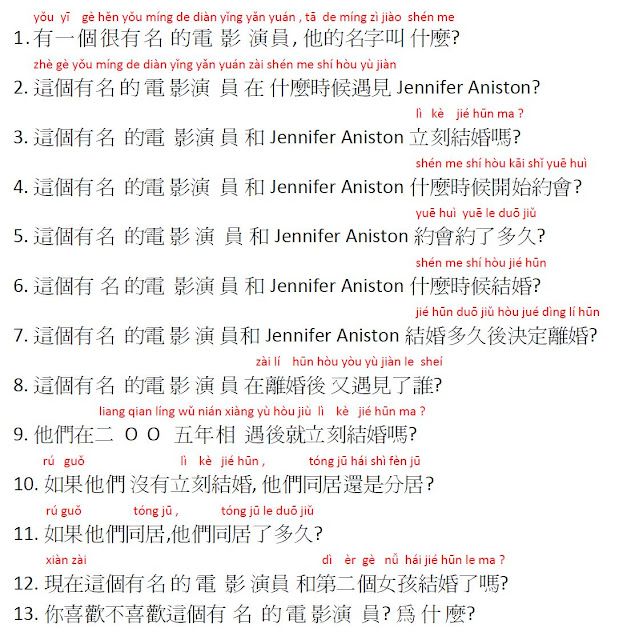For Chinese Level I students we learned the following words -
書包
shū bāo = backpack (for the purpose of school use/ school study)
買
mǎi = buy
家樂福
jiā lè fú = Carrifoure
找
zhǎo = look for
找不到
zhǎo bù dào = can't find
supplementary words...
賣
mài = sell
背包
bèi bāo = backpack
找到
zhǎo dào = find
如果
rú guǒ = if
學校
xué xiào = school
學生
xué shēng = student
We only had enough time to learn the words and to act out the story at 1st period; 2nd graders from Lan Laoshi (Mr. Law) brought his students to my class and we played a "henbanz" game which students work as pairs; a student in the pair wears a band with a picture on it without looking what the picture is. S/he has to ask as many questions as s/he can to figure out what the picture is and the other student needs to provide the answers to the questions that his/her partner asks.
For 2nd period students after we introduced the new words; we practiced these words. Instead of using small whiteboards, we practiced on these words on a sheet of paper. We folded the paper into 8 boxes. The teacher said, 找, and students write its pinyin, Chinese characters, and English meaning in a box. We practiced 15 words such as 找
zhǎo , 書
shū , 找
zhǎo書
shū, 找
zhǎo到
dào, 找
zhǎo到
dào書
shū, 找
zhǎo不
bù 到
dào , 找
zhǎo不
bù到
dào書
shū ... etc.
Later we acted out the story twice with different students.
Next, the teacher read the sentence word by word in a backward way and students chorally translated into English. And then the teacher said the sentence word by word in a backward way and students chorally translate into Chinese.
For Chinese Level II and III
We learned the following new words --
孤單
gū dān = alone (with lonely)
寂寞jì mò = lonely
羨幕
xiàn mù = (be) jealous
忌妒
jì dù = envy
結婚
jié hūn = get married
離婚
lí hūn = divorce
單身
dān shēn = single
Supplementary words
同居
tóng jū = live together
分居
fèn jū= live separately
情侶
qíng lǚ = a couple (unmarried)
夫妻
fū qī = a couple (married)
一旦
yī dàn = once
開始
kāi shǐ = start, begin
自由
zì yóu = freedom/liberty
享受
xiǎng shòu= enjoy
We talked about the singles would like to get married while married people would like to have freedom. :)
hěn duō dān shēn de rén xiàn mù jié hūn de rén
很多單身的人羨慕結婚的人 = lots of singles envy the married.
kě shì yī dàn tā men jié hūn le
可是一旦他們結婚了 = but once they get married,
tā men kāi shǐ xiàn mù dān shēn de rén
他們開始羨幕單身的人= they start to envy the singles.
wèi shén me dān shēn de rén xiàn mù jié hūn de rén
We also talked about
為甚麼單身的人羨慕結婚的人= why do singles envy the married?
Some students said ...
yīn wéi tā men hěn jì mò
因為他們很寂寞, = because they are lonely,
yīn wéi tā men bù xǐ huān jì mò
因為他們不喜歡寂寞, = because they don't like loneliness,
yīn wéi tā men bù xǐ huān gū dān
因為他們不喜歡孤單 = because they don't like to be alone.
We also talked about
wèi shén me yī dàn tā men jié hūn le tā men kāi shǐ xiàn mù dān shēn de rén
為甚麼一旦他們結婚了,他們開始羨幕單身的人?
= why once they get married, they start to envy the singles.
Some students said ...
yīn wéi tā men xiǎng yào zì yóu
因為他們想要自由 = because they want freedom.
yīn wéi tā men xiǎng yào xiǎng shòu zì yóu
因為他們想要 享受 自由= because they want to enjoy freedom.
After the discussion, we practiced these words. Instead of using small whiteboards, we practiced on these words on a sheet of paper. We folded the paper into 16 boxes. The teacher said, 孤單, and students write its Chinese characters and draw a picture to its meaing on the front, and write its English meaning and pinyin in the back.


(By Briant Johnson, a Chinese Level II student)
Next, after we practices these words we played a game - who is faster. Students work as pairs and only use one sheet of the 16 box flashcard. Have the Chinese characters face up. Students are asked to listen to the teacher and point at the words they hear. The faster one will receive the extra point.














